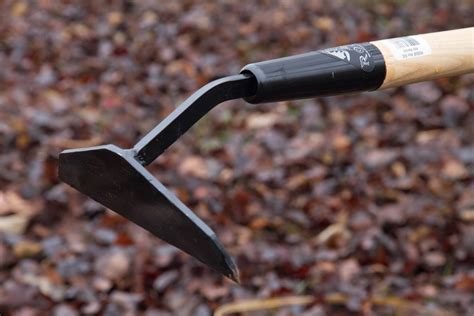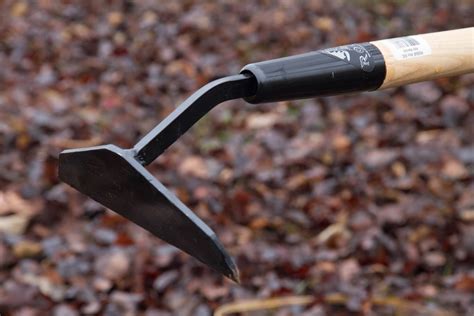The Comprehensive Guide to Using a Hoe
A hoe is a versatile gardening tool that can be used for a variety of tasks, from weeding to cultivating soil. It’s a simple yet effective tool that can be found at most garden centers and hardware stores. However, there’s more to using a hoe than meets the eye. This guide will delve into various aspects of using a hoe, addressing the most common questions beginners and seasoned gardeners might have.
What is a Hoe Used for?
A hoe is a gardening tool with a long handle and a flat blade, typically made of metal. It is primarily used for:
- Weeding: Hoes effectively remove weeds by cutting them off at the root level. This prevents them from regrowing and helps maintain the health of your garden.
- Cultivating soil: Hoes are also useful for breaking up compacted soil, aerating it, and improving drainage. This makes it easier for roots to grow and absorb nutrients.
- Hilling plants: You can use a hoe to create mounds of soil around plants, known as hilling, which helps stabilize them and prevent them from falling over.
- Making furrows: Hoes are great for creating shallow furrows in the soil for planting seeds or transplanting seedlings.
- Creating paths: You can use a hoe to create walkways in your garden by removing weeds and smoothing out the soil.
The exact purpose of a hoe can vary depending on the type of hoe used, its shape, and the specific gardening task at hand.

How Do You Use a Hoe for Weeding?
Using a hoe for weeding is an efficient way to keep your garden clean and healthy. Here’s how to do it effectively:
- Choose the right hoe: For weeding, a Dutch hoe or a stirrup hoe is generally preferred. These hoes have a narrow blade that makes it easier to get between plants and remove weeds without damaging them.
- Adjust the hoe handle: Adjust the height of the hoe handle so you can stand upright and use the tool comfortably. This reduces strain on your back.
- Position the hoe blade: Place the blade of the hoe at a slight angle to the soil, just beneath the surface. This will help you slice through the weeds effectively.
- Use a sweeping motion: Pull the hoe back and forth in a sweeping motion, slicing through the weeds at the base. The goal is to cut the weeds off at the root level to prevent them from regrowing.
- Remove the weeds: Once you have cut the weeds, you can either leave them to decompose or remove them from the garden.
Remember to be careful when using a hoe for weeding. The sharp blade can cause injuries if you are not careful. Keep a safe distance from plants and use the tool with a light touch.
What Kind of Hoe is Best for Me?
Choosing the right hoe for your gardening needs depends on the tasks you plan to accomplish. There are numerous types of hoes available, each with unique features and purposes.
Here’s a breakdown of common hoe types:
| Type of Hoe | Description | Uses |
|---|---|---|
| Dutch Hoe | This hoe has a narrow, curved blade that is excellent for weeding and shallow cultivation. | Weeding, shallow cultivation, removing small weeds |
| Stirrup Hoe | The stirrup hoe has a flat blade that’s best for breaking up soil, aerating, and preparing seedbeds. It’s also good for hilling. | Cultivating soil, aerating, preparing seedbeds, hilling |
| Collinear Hoe | This hoe has a rectangular blade and is designed for creating furrows, planting seeds, and cultivating. It’s often used in row gardening. | Creating furrows, planting seeds, cultivating, row gardening |
| Diamond Hoe | This hoe features a diamond-shaped blade, making it excellent for cutting through weeds, breaking up soil, and hilling. | Weeding, cultivating, hilling |
| Sweep Hoe | This hoe has a wide, flat blade designed to smooth out soil and remove surface weeds. | Smoothing soil, removing surface weeds, creating paths |
When selecting a hoe, consider the size of your garden, the type of soil you have, and the specific gardening tasks you intend to perform.
How Do You Use a Hoe to Cultivate Soil?
Using a hoe to cultivate soil is an important aspect of maintaining a healthy garden. Here’s a step-by-step guide:
- Choose the right hoe: For cultivating, a stirrup hoe or a diamond hoe is generally preferred. These hoes have wide blades that make it easier to break up compacted soil.
- Prepare the soil: If the soil is too dry, water it thoroughly a few hours before cultivating. This will make the soil easier to work with.
- Start at the edge of the garden: Begin cultivating at the edge of your garden bed and work your way inward.
- Use a slicing motion: Place the hoe blade at an angle to the soil and slice through it, breaking up the soil into smaller pieces.
- Work the soil to a depth of 2-3 inches: Cultivate the soil to a depth of 2-3 inches, making sure to loosen the entire area. Don’t cultivate too deep, as this can damage roots.
- Rake the soil smooth: Once you have cultivated the soil, use a rake to smooth it out and remove any large clumps.
Regular soil cultivation improves drainage, aeration, and nutrient absorption, creating a healthier growing environment for your plants.

How Often Should I Use a Hoe?
The frequency of using a hoe depends on several factors, including the type of soil, the climate, and the plants growing in your garden. However, here are some general guidelines:
- For weeding: Hoe your garden regularly to prevent weeds from getting out of control. This might be weekly or even more often during the growing season.
- For cultivating soil: Cultivate the soil in the spring before planting and again in the fall after harvesting. You can also cultivate the soil after heavy rains or if it becomes compacted.
It’s best to observe your garden and adjust the frequency of using a hoe based on your specific needs.
What Are Some Tips for Using a Hoe Effectively?
Using a hoe effectively requires a little practice and understanding. Here are some tips to make your hoeing experience smoother:
- Start with a sharp blade: A sharp hoe blade makes the job much easier and less strenuous. Sharpen the blade regularly to maintain its effectiveness.
- Use the right technique: Using a sweeping motion with a slight angle is more efficient than trying to push or pull the hoe forcefully.
- Take breaks: Hoeing can be physically demanding, so take breaks to avoid fatigue and injuries.
- Work with the soil, not against it: Don’t force the hoe into the soil. Let the blade glide through it easily. This will help you avoid breaking the tool and ensure smooth results.
- Be mindful of your plants: Keep a safe distance from plants to avoid damaging them with the hoe blade.
Practicing good technique and using a sharp hoe will make your gardening tasks more efficient and enjoyable.
How Do I Know if My Hoe Is Too Sharp?
A sharp hoe blade is essential for efficient gardening, but too sharp of a blade can be dangerous. You can tell if your hoe is too sharp by:
- The blade easily cuts your skin: If you can easily cut yourself with the blade, it’s too sharp and needs to be dulled down.
- The blade digs into the ground too easily: If the hoe digs into the soil with minimal pressure, it’s likely too sharp and could damage your plants.
- You feel a strong resistance when using it: A very sharp blade might feel more like you’re trying to hack through the soil rather than slicing it.
You can safely dull down a too-sharp hoe blade by:
- Use a whetstone: Use a coarse-grit whetstone to gently grind down the sharp edge of the blade.
- Use a file: A flat file can be used to slightly round off the sharp edges of the blade.
- Use a hammer: Gently tap the edge of the hoe blade with a hammer to slightly blunt the sharpness.
Remember to use caution when working with sharp tools and always wear protective gloves.
How Do I Clean and Maintain My Hoe?
Proper cleaning and maintenance are crucial for keeping your hoe in optimal condition and extending its lifespan.
- Clean after use: Rinse off any soil or debris from the blade and handle after each use. You can use a brush to remove stubborn dirt.
- Dry thoroughly: Make sure the blade and handle are completely dry to prevent rusting.
- Lubricate the blade: Apply a light coat of oil to the blade to prevent rusting and keep it smooth.
- Store properly: Store your hoe in a dry place, preferably in a tool shed or garage, to prevent rust and damage.
- Sharpen regularly: Sharpen the blade of your hoe regularly, especially after extended use or if it becomes dull. A sharp blade is more efficient and reduces strain on your hands and wrists.
Regular cleaning and maintenance of your hoe will ensure its longevity and make your gardening tasks more enjoyable.
What Safety Precautions Should I Take When Using a Hoe?
Using a hoe involves handling sharp tools, so it’s essential to prioritize safety. Here are some safety precautions to consider:
- Wear gloves: Always wear sturdy gloves when using a hoe to protect your hands from sharp blades and blisters.
- Wear protective footwear: Wear closed-toe shoes or boots to protect your feet from potential injuries.
- Be aware of surroundings: Be mindful of your surroundings when hoeing, especially if there are other people or pets present.
- Use a light touch: Avoid pushing or pulling the hoe forcefully. Use a gentle, sweeping motion to prevent accidental injuries.
- Keep the blade sharp: A sharp hoe blade is more efficient and safer than a dull one.
- Store properly: Store your hoe safely and out of reach of children and pets when not in use.
By following these safety precautions, you can minimize the risk of injuries while gardening and enjoy the benefits of using a hoe effectively.

What Are Some Common Mistakes People Make When Using a Hoe?
Even experienced gardeners can make mistakes when using a hoe. Here are some common mistakes to avoid:
- Using a dull hoe: A dull hoe blade is more difficult to use and can be dangerous. Sharpen your hoe regularly to ensure its effectiveness.
- Using a hoe that is too sharp: A too-sharp blade can be dangerous and may damage your plants. Make sure the blade is sharp but not overly sharp.
- Forcing the hoe into the soil: This can lead to tool damage and back strain. Let the blade glide through the soil smoothly.
- Not being mindful of surroundings: Be aware of your surroundings, especially if there are other people or pets present, to avoid accidental injuries.
- Ignoring safety precautions: Always wear gloves, protective footwear, and use a light touch when hoeing to avoid injuries.
- Not cleaning and maintaining the hoe: Neglecting to clean and maintain your hoe can lead to rusting and damage, shortening its lifespan.
By avoiding these mistakes, you can ensure that you are using a hoe safely and effectively and making your gardening tasks more enjoyable.
What Are Some Alternatives to Using a Hoe?
While hoes are versatile tools, there are alternative methods for various gardening tasks. Here are a few options:
- Hand weeding: For small gardens or delicate areas, hand weeding can be a more precise approach. You can use hand tools like weeding trowels or a hand cultivator.
- Mulching: Applying a layer of mulch, like wood chips or straw, can suppress weed growth and reduce the need for frequent hoeing.
- Using a tiller: For larger areas, a tiller can be a more efficient tool for breaking up soil and preparing seedbeds.
- Using a cultivator: A cultivator is a tool with multiple tines that can loosen soil and remove weeds. It’s a good alternative to a hoe for aerating soil and preparing planting beds.
The best alternative for you will depend on the size of your garden, the type of soil, and the tasks you need to accomplish.
Table Summary
| Task | Recommended Hoe Type | Key Tips |
|---|---|---|
| Weeding | Dutch Hoe, Stirrup Hoe | Use a sweeping motion, be mindful of plants. |
| Cultivating Soil | Stirrup Hoe, Diamond Hoe | Work the soil to a depth of 2-3 inches, rake smooth. |
| Hilling | Stirrup Hoe, Diamond Hoe | Create mounds of soil around plants to stabilize them. |
| Making Furrows | Collinear Hoe | Create shallow furrows for planting seeds or transplanting seedlings. |
| Creating Paths | Sweep Hoe | Remove weeds and smooth out the soil to create walkways. |
Frequently Asked Questions (FAQ)
How long does it take to learn to use a hoe?
Learning to use a hoe effectively can be relatively quick. With a little practice and patience, you can master the basics in just a few uses. The key is to start with a simple task, like weeding, and gradually move on to more complex techniques like cultivating soil.
Can I use a hoe on all types of soil?
While hoes are versatile tools, they may not be suitable for all types of soil. For instance, a hoe might be less effective on very hard, compacted clay soil. It’s best to choose a hoe suited for your soil type and consider alternative methods like tilling for more challenging soil conditions.
Is there a right way to hold a hoe?
Yes, there is a correct way to hold a hoe for optimal comfort and efficiency. You should hold the hoe handle with a firm grip, but not too tightly. Keep your arms extended and use your body weight to move the blade through the soil, not just your arm muscles. This reduces strain and improves control.
How do I dispose of a broken hoe?
Properly dispose of a broken hoe depends on local regulations and the type of material. Check with your local waste management company for guidance. It’s generally best to remove the blade from the handle and dispose of them separately. You can also consider recycling or donating the parts if possible.
How can I make using a hoe more enjoyable?
Making hoeing more enjoyable can involve using a sharp tool, practicing proper technique, and making the process more efficient. You can also consider incorporating music or podcasts into your gardening routine, making it more engaging. Remember, a well-maintained hoe and efficient technique can make all the difference.
What are some benefits of using a hoe?
Using a hoe offers numerous benefits for your garden and your well-being. They help control weeds, improve soil health, and provide a physical workout. Hoes can also be a more environmentally friendly option compared to using chemical herbicides.
What are some tips for using a hoe in a small garden?
In a small garden, using a hoe requires precision and care. Choose a small-sized hoe with a narrow blade for easier maneuvering between plants. Be cautious around delicate plants and use the tool with a light touch. Consider hand weeding for very small areas or those with densely packed plants.



